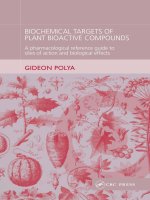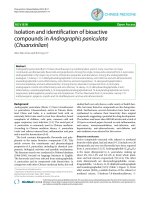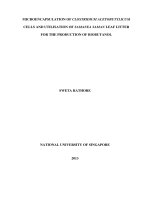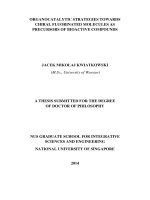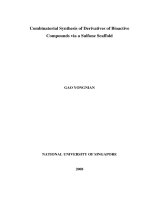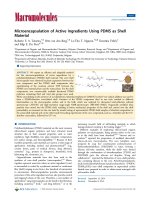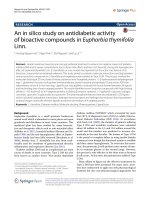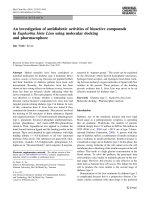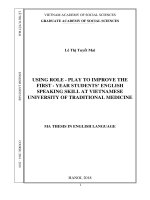Microencapsulation of lipophilic bioactive compounds using prebiotic carbohydrates: Effect of the degree of inulin polymerization
Bạn đang xem bản rút gọn của tài liệu. Xem và tải ngay bản đầy đủ của tài liệu tại đây (2.06 MB, 9 trang )
Carbohydrate Polymers 152 (2016) 775–783
Contents lists available at ScienceDirect
Carbohydrate Polymers
journal homepage: www.elsevier.com/locate/carbpol
Microencapsulation of lipophilic bioactive compounds using prebiotic
carbohydrates: Effect of the degree of inulin polymerization
Eric Keven Silva a,∗ , Giovani L. Zabot b , Matheus A. Bargas a , M. Angela A. Meireles a
a
b
LASEFI/DEA/FEA (School of Food Engineering)/UNICAMP (University of Campinas), Rua Monteiro Lobato, 80, Campinas, SP, CEP: 13083-862, Brazil
Federal University of Santa Maria, UFSM, Rua Ernesto Barros, 1345, Cachoeira do Sul, RS, 96506-322, Brazil
a r t i c l e
i n f o
Article history:
Received 18 May 2016
Received in revised form 5 July 2016
Accepted 17 July 2016
Available online 18 July 2016
Keywords:
Fructooligosaccharide
Functional carbohydrate
Glass transition temperature
Wall material
Water adsorption isotherms
a b s t r a c t
This paper presents novel outcomes about the effect of degree of inulin polymerization (DP) on the technological properties of annatto seed oil powder obtained by freeze-drying. Inulins with two DP’s were
evaluated: GR-inulin (DP ≥ 10) and HP-inulin (DP ≥ 23). Micrographs obtained by confocal microscopy
were analyzed to confirm the encapsulation of bioactive compounds using both inulins, especially the
encapsulation of the natural fluorescent substance ␦-tocotrienol. Microparticles formed with both inulins
presented the same capacity for geranylgeraniol retention (77%). Glass transitions of microparticles
formed with GR-inulin and HP-inulin succeeded at 144 ◦ C and 169 ◦ C, respectively. Regarding water
adsorption isotherms, microparticles formed with HP-inulin and GR-inulin presented behaviors of Types
II (sigmoidal) and III (non-sigmoidal), respectively. Reduction of water adsorption capacity in the matrix
at high relative moistures ( > 70%) was presented when HP-inulin was used. At low relative moistures
( < 30%), the opposite behavior was observed.
© 2016 Elsevier Ltd. All rights reserved.
1. Introduction
The crescent interest of developing prebiotic substances is
aimed at non-digestible oligosaccharides. One of the prebiotics is
inulin, a fructooligosaccharide generally extracted from chicory
(Pandey et al., 1999), but also from other sources as artichoke
(Ruiz-Aceituno, García-Sarrió, Alonso-Rodriguez, Ramos, & Sanz,
2016), and used for stabilizing proteins (Mensink, Frijlink, van der
Voort Maarschalk, & Hinrichs, 2015) or converted into other functional ingredients by inulinases (Mazutti et al., 2010). Longer chain
lengths make inulin as dietary fiber useful for food and pharmaceutical applications. Examples of applications include as low caloric
sweetener, as substance that provides solid dispersion for increasing dissolution rate, as an agent to form gels and to increase the
viscosity of solutions, and as a non-digestible fiber (Mensink et al.,
2015). Inulin also presents the ability to change the gut flora composition after a short feeding period based on results from in vitro
studies and human subjects (Kolida & Gibson, 2007).
The use of inulin depends on its degree of polymerization (DP).
The molecular chain length can range some extent, commonly
between 4 and 80 (Mensink et al., 2015). The degree of inulin poly-
∗ Corresponding author.
E-mail address: (E.K. Silva).
/>0144-8617/© 2016 Elsevier Ltd. All rights reserved.
merization depends on the harvest time, storage time/temperature
and growing conditions (Saengthongpinit & Sajjaanantakul, 2005).
Consequently, the degree of inulin polymerization determines the
physicochemical characteristics to a substantial extent, as morphology (i. e., crystal morphology, crystal structure and structure in
solution), solubility, rheology (i. e., viscosity, hydrodynamic shape
and gelling), thermal characteristics and physical stability (i. e.,
glass transition temperature, vapor sorption and melting temperature) and chemical stability (Mensink et al., 2015).
Following the scenario of using inulin as prebiotic substance
(Zabot, Silva, Azevedo, & Meireles, 2016), bioactive compounds
extracted from vegetal sources are also of recent interest because of
their functional properties. Annatto seed oil is one of the sources of
value-added bioactive compounds, as ␦-tocotrienol (Albuquerque
& Meireles, 2012; Moraes, Zabot, & Meireles, 2015) and geranylgeraniol (Silva, Zabot, & Meireles, 2015). Tocotrienol-rich fractions
obtained from annatto seeds act as natural antioxidants by inhibiting lipid oxidation of fish oil and lipid-based formula emulsions
(Zou & Akoh, 2015). In addition, geranylgeraniol modulates the
apoptosis of carcinogen cells (Marcuzzi et al., 2012).
In this context, the objective of this study was to evaluate
the influence of the degree of inulin polymerization (DP ≥ 10 and
DP ≥ 23) on the physical properties of annatto seed oil microparticles obtained by freeze-drying. Inulin was used as encapsulating
matrix and the effect of its degree of polymerization on the recon-
776
E.K. Silva et al. / Carbohydrate Polymers 152 (2016) 775–783
stitution properties of the emulsions was assessed. Furthermore,
the morphology and ␦-tocotrienol distribution in the particles
microstructures, geranylgeraniol retention by the encapsulating
matrices, glass transition of microparticles and physical stability
through water adsorption isotherms were also the responses taken
into account when evaluating the effect of the degree of inulin
polymerization.
were performed at 25 ◦ C. The mean diameter was calculated based
on the mean diameter of a sphere of similar area, superficial mean
diameter (D32 ), as Eq. (1). Polydispersity index (PDI) was calculated
as Eq. (2). All samples were analyzed through the wet method, with
dispersion in water and refractive index of 1.52.
D32 =
2. Material and methods
PDI =
2.1. Annatto seed oil extraction
Annatto seed oil used as active material was extracted with
supercritical CO2 using a pilot scale equipment (Thar Technologies,
Pittsburgh, USA) containing an extraction vessel of 5 L with internal
diameter of 10.2 cm. Solvent flow rate was equal to 200 g CO2 /min
and the bed was maintained at 40 ◦ C and 20 MPa, as described
in detail by a previous study (Silva, Gomes, Hubinger, Cunha, &
Meireles, 2015).
2.2. Inulins and materials for chromatographic analyses
Inulins used as active materials for encapsulating annatto
seed oil were both from chicory: Orafti® GR (GR-inulin, DP ≥ 10)
and Orafti® HP (HP-inulin, DP ≥ 23) (BENEO-Orafti, São Paulo,
Brazil). Materials for chromatographic analyses were: methanol,
ethanol and hexane (Chemco, Hortolândia, Brazil); geranylgeraniol
(purity > 85%, Sigma–Aldrich, Steinhein, Germany) and ammonium
acetate (P.A., Dinâmica, Campinas, Brazil).
2.3. Microencapsulation of annatto seed oil
Annatto seed oil was encapsulated with GR- and HP-inulins
through emulsification assisted by ultrasound with nominal power
of 160 W during 3 min using a 13 mm diameter, 19 kHz ultrasonic
probe (Unique, Disruptor, 800 W, Indaiatuba, Brazil) for each 30 mL
of emulsion. Total concentration of solids in the emulsion (emulsifying + oil) was equal to 20 g/100 g of emulsion. Annatto seed oil was
added to the suspensions containing GR- and HP-inulins and the
concentration of oil was maintained at 20% relative to the amount
of solids, that is, 4 g of oil per 100 g of emulsion. Immediately after
homogenization, the emulsions were frozen in aluminum plates
at −40 ◦ C for 3 h and then subjected to freeze-drying (FD) process. Drying was performed in a freeze-dryer system (Liobras, L
101, Sao Carlos, Brazil). The dried emulsions were converted into
fine powders through maceration. Detailed description of obtaining annatto seed oil microparticles is reported by a previous study
(Silva & Meireles, 2015).
2.4. Reconstitution properties of emulsions
The wettability of the powders was determined as the method
reported by Fuchs et al. (2006), with a few modifications. The samples of powders (0.1 g) were dispersed over water surface of a
Becker containing 100 mL of ultrapure water under stirring at 25 ◦ C.
The time spent for immersing or wetting the last particle of powder
was used as wettability response.
The annatto seed oil microparticles obtained by freeze-drying
were reconstituted in ultrapure water. An amount of 2 g of powder
was mixed with 8 g of ultrapure water and the solution was stirred
during 30 s in a vortex type homogenizer (PHOENIX, AP-56 model,
Araraquara, São Paulo, Brazil) at 25 ◦ C.
Droplet size distribution and mean diameter of the emulsion
droplets, after reconstitution and before drying, were determined
by light scattering technique using laser diffraction (Mastersizer
2000 Malvern Instruments Ltd, Malvern, UK). The measurements
ni di
3
ni di
2
(d90 − d10 )
d50
(1)
(2)
Where: di is the mean diameter of the droplets; ni is the number
of droplets; and d10 , d50 and d90 are the diameters at 10%, 50% and
90% of cumulative volume, respectively.
2.5. Scanning electron microscopy (SEM)
Micrographs were taken in a scanning electron microscope
with Energy Dispersive X-ray Detector (SEM) (Leo 440i, EDS 6070,
SEM/EDS: LEO Electron Microscopy/Oxford, Cambridge, England).
Analyses were performed with 5 kV accelerating voltage and 50 pA
beam current for obtaining the micrographs.
2.6. Confocal scanning laser microscopy (CSLM)
CSLM analysis was performed using a Zeiss LSM 780-NLO confocal on an Axio Observer Z.1 microscope (Carl Zeiss AG, Germany)
with a 40 × objective. Images were taken by exciting ␦-tocotrienol
molecules with lasers at 488 nm wavelength, without any previous preparation of the samples as a consequence of the fluorescent
properties of ␦-tocotrienol, similarly to the procedure described by
a previous study (Silva, Zabot, Cazarin, Maróstica Jr., & Meireles,
2016).
2.7. Geranylgeraniol retention
Geranylgeraniol content in annatto seed oil (before and after
encapsulation) was determined by high-performance liquid chromatography (HPLC). Chromatographic analyses were accomplished
using an HPLC-PDA (Waters, Alliance E2695, Milford, USA) system, consisting of a separation module with an integrated column
heater, an autosampler and a photodiode array (PDA) detector. Separation of geranylgeraniol was fulfilled using a fused-core type
column (Kinetex, C18 , 100 mm × 4.6 mm × 2.6 m; Phenomenex,
Torrance, USA). An aliquot of 10 L of each sample diluted to
500 ppm (w/w) in hexane (Chemco, Hortolandia, Brazil) and filtered using nylon membrane (0.45 m) was injected. A solution of
methanol:ammonium acetate 50 mM (90:10, v/v) was the mobile
phase. The column was maintained at 40 ◦ C. Mobile phase flow
rate was 1 mL/min and the analytical run time was 7 min. Detector
wavelength range was 200–400 nm. Geranylgeraniol was detected
at 210 nm and at 2.4 min, and its quantification was performed
using external standard calibration curve.
Intending to quantify geranylgeraniol entrapped in the
microparticles after using inulins with two degrees of polymerization, four procedures were carried out to break the structure for
releasing such compound:
I Centrifugation: Approximately 0.1 g of particles from each
treatment was mixed with 4 mL of ultra-pure water. The samples were maintained static during 24 h; thereafter, they were
manually agitated for reconstituting the emulsions. Aliquots of
0.5 mL were transferred to an Eppendorf tube of 2 mL containing 1.3 mL of hexane. The mixtures were then centrifuged at
5000 rpm for 20 min and at 10,000 rpm for 5 min. This procedure was performed to break the emulsion and to capture the
E.K. Silva et al. / Carbohydrate Polymers 152 (2016) 775–783
777
bioactive material. The superior phase was collected and the geranylgeraniol content was analyzed as following the analytical
procedures used for pure annatto seed oil (oil before encapsulation).
II Diffusion in hexane and extraction assisted by ultrasound:
Approximately 0.1 g of particles from each treatment was mixed
with 20 mL of hexane. The samples were maintained static during 24 h for attaining the diffusion of geranylgeraniol. In the
sequence, the samples were sonicated at 600 W during 2 min
using a 13 mm diameter, 19 kHz ultrasonic probe (Unique, Disruptor, 800 W, Indaiatuba, Brazil). Afterwards, an aliquot was
taken and subjected to chromatographic analyses following the
same procedures developed with pure oil.
III Diffusion in ethanol and extraction assisted by ultrasound:
This procedure was accomplished similarly to procedure II. The
only one difference was the substitution of hexane by ethanol.
IV Diffusion in ethanol:water solution and extraction assisted by
ultrasound: This procedure was accomplished similarly to procedures II and III. The only one difference was the substitution
of hexane or ethanol by ethanol:water (1:1, w/w) solution.
Table 1
Reconstitution properties of annatto seed oil powders.
2.8. Differential scanning calorimetry (DSC)
Minitab 16® software was used to perform the analysis of variance for verifying the effects of the degrees of inulin polymerization
on the microparticles characteristics. Differences between average
values were compared using Tukey’s test with 5% of significance
(p-value < 0.05). DSC results were analyzed by descriptive approach.
DSC analysis was performed using calorimeter equipment (TA
60, Shimadzu Corporation, Kyoto, Japan) for determining the glass
transition temperature (Tg) of microparticles and inulins used as
wall material. Approximately 2 mg of sample, under an atmosphere
with 10 mL/min of nitrogen, was submitted to two heating gradients for constructing DSC curves: 25 ◦ C to 110 ◦ C with scanning
rate of 10 ◦ C/min and isothermal period of 5 min (first run); 25 ◦ C
to 250 ◦ C (second run). Tg was observed in the second run at the
midpoint of the glass transition range (Botrel, de Barros Fernandes,
Borges, & Yoshida, 2014).
2.9. Water adsorption isotherms
Water adsorption isotherms of microparticles containing
annatto seed oil, formed with both degrees of polymerization, were determined by the gravimetric static method (Silva,
Borges, da Costa, & Queiroz, 2015; Silva, Fernandes, Borges,
Botrel, & Queiroz, 2014). The samples were conditioned in phosphorous pentoxide previously of performing the assays, until
constant weight. Such procedure was fulfilled to assure that
only the adsorption phenomenon could be observed for all relative moistures evaluated in the experiment. Afterwards, the
microparticles were stored at 30 ◦ C under some relative moisture conditions (11.28% to 90.20%) provided by seven saturated
saline solutions (lithium chloride, magnesium chloride, potassium
carbonate, sodium bromide, sodium chloride, potassium chloride
and barium chloride) (Greenspan, 1977). The parameters of the
Guggenheim–Anderson–de Boer (GAB) model (Eq. (3)) (Van den
Berg, 1984) were fitted using the experimental data of equilibrium
moisture. The Quasi-Newton nonlinear regression was used with a
convergence criterion of 10−4 on the Statistica software (Statsoft,
8.0, 2007).
Xeq =
Xm CKaw
(1 − Kaw ) (1 − Kaw + CKaw )
(3)
Where: Xeq is the equilibrium moisture (g water/100 g dry solids);
Xm is the monolayer moisture content (g water/100 g dry solids); aw
is the water activity (dimensionless); C is a constant representing
the adsorption on the first monolayer; K is a constant representing
the adsorption of molecules of water on multilayers.
Microparticles
Wettability (s)
16 ± 1
57 ± 1
GR-FD
HP-FD
D32
(m)
PDI
FE
RE
FE
RE
2.4 ± 0.5
3.7 ± 0.1
5.9 ± 0.2
4.5 ± 0.2
2.0 ± 0.1
5±2
7±2
5±1
FE: fresh emulsion; RE: reconstituted emulsion.
The fit of the model parameters was assessed based on the
coefficient of determination (R2 ) and the mean relative percentage
deviation modulus (E) (Eq. (4)):
E=
100
n
n
i=1
|Y − Yˆ |
Y
(4)
Where: Y is the observed value; Yˆ is the model estimated value; n
is the number of observed data.
2.10. Statistical analysis
3. Results and discussion
3.1. Reconstitution properties of annatto seed oil emulsions
The evaluation of reconstitution properties of particulate systems allows predicting the best conditions for applying and
distributing encapsulated active compounds. In this sense, the wettability is one of the more important physical properties taken into
account when the characteristics of reconstituted powder products are evaluated, because the wettability expresses the capacity
of the product to adsorb water. Then, the responses of wettability of annatto seed oil microparticles formed with inulins of two
degrees of polymerization (GR-inulin, DP ≥ 10; HP-inulin, DP ≥ 23)
as encapsulating matrices are presented (Table 1).
The use of GR-inulin (lower DP) enabled the formation of
microparticles with higher instantisation velocity. This result could
be associated with the differences on the molecular chain, because
larger molecular chains could act as physical barrier against
water penetration, thus reducing the velocity of water absorption. Fernandes, Borges, and Botrel (2014) evaluated the wettability
of rosemary essential oil microparticles obtained by spray-drying.
The authors used blends of inulin/Arabic gum and inulin/modified
starch, both with the same mass proportion of wall materials
(1:1). The findings indicated the inulin/Arabic gum blend presented
instantisation at 93 ± 9 s, while inulin/modified starch blend presented instantisation at 131 ± 8 s.
Droplet size distributions of annatto seed oil emulsions stabilized by GR- and HP-inulins in fresh state (before freeze-drying)
and reconstituted state are presented (Fig. 1). For both treatments,
the patterns were different when the fresh and reconstituted emulsions are compared. In addition, bimodal distributions are seen. The
responses of D32 and PDI (Table 1) corroborate the performance of
GR-FD and HP-FD microparticles, which the responses were not
satisfactory, mainly with respect to the reconstitution properties.
Such responses are associated with the lack of superficial activity of
inulin molecule, regardless of its degree of polymerization. Inulin
alone as wall material cannot form interfacial films over the annatto
seed oil droplets. The main mechanism for emulsions stabilization
778
E.K. Silva et al. / Carbohydrate Polymers 152 (2016) 775–783
Fig. 1. Droplet size distributions of fresh and reconstituted emulsions and visual aspect of emulsions stored during 24 h after reconstitution.
is linked to the inulin action as thickener of continuous phase, creating a physical barrier against the coalescence of oil droplets (Silva,
Gomes, et al., 2015). The visual aspect of emulsions stored during 24 h after reconstitution is also presented (Fig. 1). The emulsion
stabilized with HP-inulin showed stability against phase separation
after the reconstitution. However, the emulsion stabilized with GRinulin was unstable during the storage period. The findings could
be associated with the degree of inulin polymerization, because
the highest degree led to the formation of a thickener continuous
phase, more efficient for reducing the coalescence of oil droplets
(Silva & Meireles, 2015).
3.2. Microstructural analysis
The morphology of annatto seed oil microparticles formed with
two degrees of polymerization (GR: DP ≥ 10; HP: DP ≥ 23) is presented after performing SEM and CSLM analyses (Fig. 2). SEM is
an important analysis used for characterizing the microstructure
of particulate products. With the micrographs, the effects of the
process on microparticles formation and the effects of composition of wall materials on the morphological characteristics of the
powder products can be assessed. Likewise, CSLM analysis is an
important tool for characterizing microstructures based on the natural fluorescent properties of compounds present in the structure
or based on the addition of substances with such properties. The
main advantage of the technique relies on the possibility of observing the internal structure of microparticles without fragmenting
the material. The results obtained after performing both analyses
(SEM and CSLM) are complementary, whereas they characterize
the morphology and distribution of the bioactive compounds on the
microstructure of the particles. Some scientific studies report these
analyses as a combined form of characterization of powder products containing encapsulated bioactive compounds (Carvalho, da
Costa Machado, da Silva, Sartoratto, Rodrigues, & Hubinger, 2016;
Silva, Azevedo, Cunha, Hubinger, & Meireles, 2016).
The regions in fluorescent green (Fig. 2) indicate the distribution of ␦-tocotrienol in the microparticles structure, which means
annatto seed oil was distributed through the encapsulating matrix.
Albuquerque and Meireles (2012) reported annatto seed oil is the
richest source of ␦-tocotrienol, containing approximately 15 g ␦tocotrienol/100 g oil. Therefore, we infer both inulins were able to
entrap ␦-tocotrienol inside the matrix (qualitative analysis).
Regardless the degree of inulin polymerization, all microparticles presented irregular morphology, typical of freeze-dried
materials (Chranioti, Chanioti, & Tzia, 2016). The morphology is a
result of breaking the spongy structure formed after removing ice
crystals in the encapsulating system through sublimation. Regarding the microstructure, no differences were observed after using
inulins with different molecular chain lengths.
E.K. Silva et al. / Carbohydrate Polymers 152 (2016) 775–783
779
Fig. 2. SEM and CSLM micrographs of annatto seed oil microparticles.
3.3. Geranylgeraniol retention
One of the main responses when evaluating the efficiency of
an encapsulating matrix is the ability of retaining the target bioactive compound into the encapsulating system. This ability assures
the efficiency of an expected action after applying the microparticles in a determined product. In this sense, the influence of the
degree of inulin polymerization on geranylgeraniol retention was
evaluated, because geranylgeraniol presents therapeutic properties
associated with its biological activities as anti-inflammatory and
anticancer agent. Annatto seed oil, before encapsulation, presented
25.0 ± 0.6 g geranilgeraniol/100 g oil.
Recovering geranilgeraniol from annatto seed oil microparticles
aiming to perform its quantification was fulfilled through two dis-
780
E.K. Silva et al. / Carbohydrate Polymers 152 (2016) 775–783
Fig. 3. Effect of the degree of inulin polymerization on geranylgeraniol retention.
US: ultrasonication.
tinct mechanisms: i) emulsions were reconstituted by suspending
the microparticles in water followed by centrifugation to break the
colloidal system and to capture the compound; ii) suspension of
microparticles was done in different organic solvents for diffusing
the compound followed by breaking the particles microstructures
using ultrasonication. The influence of the degree of inulin polymerization on geranylgeraniol retention could be seen (Fig. 3),
where it ranged from 40% to 74% for GR-FD and from 2% to 77%
for HP-FD.
Breaking the reconstituted emulsions by centrifugation for
extracting annatto seed oil was not an efficient method to quantify geranylgeraniol, because high viscosities of emulsions acted as
an effective physical barrier to entrap the oil. The lowest extraction
found for HP-FD corroborates this observation, because the viscosity of the emulsion increases with increasing the degree of inulin
polymerization (Silva & Meireles, 2015; Silva, Gomes et al., 2015).
Diffusing the oil in organic solvent followed by sonication of
the matrix for releasing the oil was the most efficient method for
quantifying geranylgeraniol retained in the microparticles. Diffusion in ethanol or ethanol:water solution did not influence the
geranylgeraniol retention (p-value = 0.725). The lowest retention
found after using hexane as diffusion medium can be associated
with the lowest polarity of this solvent when comparing it with
the other diffusion media. Furthermore, the interaction of hexane
with the encapsulating matrix is low and not enough to break the
structure during ultrasonication.
Microparticles presented the same capacity of geranylgeraniol
retention (p-value = 0.616). Our results corroborate the entrapment
efficiencies reported by Silva and Meireles (2015). The authors
reported that the degree of inulin polymerization did not influence the oil retention in the microparticles, since GR-inulin and
HP-inulin resulted in the same entrapment efficiency of annatto
seed oil.
3.4. Glass transition temperature (Tg)
Determining Tg of dehydrated products is an important step for
characterizing particulate systems (Gomes da Costa, Silva, Toledo
Hijo, Azevedo, & Borges, 2015). Conditions of temperature above Tg
provide more molecular mobility, accelerating the reaction rates.
Conditions of temperature below Tg provide higher stability of the
products against deterioration during storage (Oikonomopoulou,
Fig. 4. DSC curves of pure inulins and annatto seed oil microparticles.
Krokida, & Karathanos, 2011). Silva and Meireles (2015) evaluated
X-ray diffractograms of GR- and HP-inulins, as well as GR-FD and
HP-FD microparticles. GR- and HP-inulins were characterized as
amorphous materials and both microparticles were characterized
as amorphous materials with crystalline regions.
Semicrystalline biopolymers can present three thermal transition characteristics: a) glass transition to amorphous fraction; b)
fusion of the crystalline fraction; c) transition as a consequence of
crystallization (Teac˘a, Bodỵrl˘au, & Spiridon, 2013). When evaluating encapsulating systems, the more relevant phase transition is
the glass transition, because Tg of amorphous materials is defined
as the temperature which the material changes from amorphous
state to gummy (elastic) state. Therefore, after the transition, the
microparticles coating structure that entrap (protect) the annatto
seed oil loose its efficiency as encapsulating matrix, releasing the
active material.
DSC curves of pure inulins and microparticles containing
annatto seed oil (Fig. 4) were obtained after the cooling period at
second scanning stage, aiming to erase the thermal history over Tg
(Haque, Kawai, & Suzuki, 2006). Overall, glass transition is evaluated in terms of the moisture of the material, because water
acts as plasticizing, thus reducing Tg as a consequence of reducing
inter and intramacromolecular forces (Chuang, Panyoyai, Shanks,
& Kasapis, 2015). The samples were analyzed at the conditions of
moisture and aw from FD process, as described by Silva and Meireles
(2015), searching for the characterization of products obtained on
their natural conditions.
According to DSC curves (Fig. 4), the phenomena of glass transition of GR, HP, GR-FD and HP-FD samples succeeded at 132 ◦ C,
157 ◦ C, 144 ◦ C and 169 ◦ C, respectively. After analyzing the pure
biopolymers, increasing the degree of polymerization increased
Tg of inulin. The molecular chain length of inulin did not influence Tg of microparticles. Although differences higher than 25 ◦ C
in the Tg of pure inulins were observed, the presence of annatto
seed oil approximated the physical properties of the systems.
Ronkart, Paquot, Fougnies, Deroanne, and Blecker (2009) evaluated
the moisture content over Tg of inulin (mean DP = 23). The authors
concluded the glass transition of inulin succeeded between 150 ◦ C
and 160 ◦ C for moisture contents below 5 wt.% (dry mass basis),
similarly to our findings.
E.K. Silva et al. / Carbohydrate Polymers 152 (2016) 775–783
781
Fig. 5. Water adsorption isotherms of annatto seed oil microparticles.
3.5. Water adsorption isotherms of annatto seed oil
microparticles
Studying the isothermal behavior of water adsorption of annatto
seed oil microparticles allows predicting the best storage conditions for maintaining long shelf life of products. Water adsorption
of dehydrated products is the main factor of degradation of such
products. Increasing moisture content, after water adsorption, can
cause several changes on the encapsulating matrix. For instance,
microparticles can agglomerate or Tg can reduce, compromising
the efficiency of the polymeric matrix.
Water adsorption isotherms of annatto seed oil at 30 ◦ C for
each degree of inulin polymerization are presented (Fig. 5). HPFD samples presented behavior of Type II: sigmoidal. According to
classification of Brunauer, Deming, and Teller (1940), this behavior
is typical of porous or macro porous materials which present high
adsorption energy. Otherwise, GR-FD samples presented behavior of Type III: non-sigmoidal. This behavior is typical of porous
or macro porous materials which present low adsorption energy.
The behaviors corroborate the differences on the equilibrium moistures observed for microparticles with relative moisture higher
Fig. 6. Images of annatto seed oil microparticles after water adsorption at seven
equilibrium relative moistures.
than 30%. In the same conditions of pressure and temperature, GRFD samples presented larger capacity of water adsorption than that
observed for HP-FD samples. Then, water adsorption in the inulin
with smaller molecular chain expends lower energy.
After comparing the behavior of the curves, reduction of water
adsorption capacity in the matrix at high relative moistures ( > 70%)
was verified when the degree of inulin polymerization is increased
(higher molecular length). However, the opposite behavior was
observed at low relative moistures ( < 30%). Similar findings were
reported by Schaller-Povolny, Smith, and Labuza (2000) when evaluating four degrees of inulin polymerization (mean DP equal to 5,
9, 11 and 23) over water adsorption isotherms at 23 ◦ C. This effect
is coupled with the molecular length and arrangement of inulin,
782
E.K. Silva et al. / Carbohydrate Polymers 152 (2016) 775–783
Table 2
Parameters fitted for GAB model.
Acknowledgements
Microparticles
Xm (g water/100 g dry solids)
C
K
R2
E (%)
GR-FD
HP-FD
5.47
5.38
5.33
30.94
0.844
0.737
0.995
0.997
4.41
0.22
which the shortest chain contains more hydroxyl groups available
to bond with water.
GAB model was used to fit the parameters that represent the
experimental data because such model can successfully describe
water isothermal adsorption of powder products (Rao & Labuza,
2012; Zhou, Liu, Chen, Chen, & Labuza, 2014). Thus, the parameters
of GAB model were fitted and the fit was evaluated statistically
(Table 2). According to high values of coefficient of determination
(R2 ≥ 0.995) and low values of mean relative percentage deviation
modulus (E ≤ 4.41), the curves fitted to the adsorption isotherms
were suitable to describe the behavior of the experimental data.
After fitting the parameters of GAB model, Xm was obtained. This
parameter comprises the content of water that is strongly adsorbed
to the bonding sites on the microparticles surface. Xm is important
for the physical stability of particulate systems against lipid oxidation, enzymatic activity, non-enzymatic browning and changes in
the structural characteristics. Therefore, Xm is considered to be the
suitable moisture content for extending the shelf life of products
(Rao & Labuza, 2012).
C and K constants of GAB model are associated with the
monolayer and monolayer properties, respectively. Ranges of
5.67 ≤ C < ∞ and 0.24 < K ≤ 1 indicate that GAB model properly
describes water adsorption isotherms (Lewicki, 1997). Increasing
K by decreasing the degree of inulin polymerization corroborates
the change of the shape of isothermal curve from Type II to Type
III.
After the equilibrium of microparticles with water vapor in
seven relative moistures, the images of the samples were taken
(Fig. 6). No visible phase transition (i. e., liquefaction) was observed
in each matrix, even though at high relative moistures. However,
the GR-FD microparticles displayed caking after submitted to relative moisture higher than 32%, whilst HP-FD microparticles were
stable at all conditions of relative moisture.
4. Conclusion
The microparticles formed and presented in this paper are highlighted as a consequence of their singular properties, which have
been not enough studied on scientific community. Such microparticles are totally functional, because the bioactive compounds
encapsulated and the encapsulating matrix are therapeutic substances to be applied in food-related and pharmaceutical-related
products. Considering the technical approach, after comparing
inulins with two degrees of polymerization (GR: DP ≥ 10; HP:
DP ≥ 23) for encapsulating annatto seed oil, the conclusion was
that the polymeric matrix influenced the microparticles properties.
When the emulsions were reconstituted, the emulsion stabilized
with HP-inulin showed stability against phase separation 24 h
after the reconstitution. Both inulins could entrap annatto seed
oil; therefore, the microparticles presented the same capacity of
geranylgeraniol retention (77%). Furthermore, for water activities
higher than 0.3, water isothermal adsorption was lower when using
HP-inulin. Images of HP-FD microparticles indicated they were
more stable at all conditions of relative moisture (11% to 90%).
Therefore, HP-inulin is inferred to be a potential encapsulating
agent of bioactive compounds extracted from vegetal sources, as
annatto seeds.
Authors are grateful to CNPq (470916/2012-5) and FAPESP
(2012/10685-8; 2015/13299-0) for the financial support. Eric
Keven Silva thanks CNPq (140275/2014-2) for the Ph.D. scholarship
and FAPESP (2015/22226-6) for the postdoctoral scholarship. Giovani L. Zabot thanks FAPESP (2014/15685-1) for the postdoctoral
scholarship. M. Angela A. Meireles thanks CNPq (302423/2015-0)
for the productivity grant. In addition, the authors would thank the
access to equipment and assistance provided by the National Institute of Science and Technology on Photonics Applied to Cell Biology
(INFABIC) at the University of Campinas; INFABIC is co-funded by
FAPESP (08/57906-3) and CNPq (573913/2008-0).
References
Albuquerque, C. L. C., & Meireles, M. A. A. (2012). Defatting of annatto seeds using
supercritical carbon dioxide as a pretreatment for the production of bixin:
Experimental, modeling and economic evaluation of the process. Journal of
Supercritical Fluids, 66, 86–94.
Botrel, D. A., de Barros Fernandes, R. V., Borges, S. V., & Yoshida, M. I. (2014).
Influence of wall matrix systems on the properties of spray-dried
microparticles containing fish oil. Food Research International, 62, 344–352.
Brunauer, S., Deming, L. S., & Teller, E. (1940). On a theory of Van der Waals
adsorption of gases. Journal of the American Chemists Society, 62, 1723–1732.
Carvalho, A. G. S., da Costa Machado, M. T., da Silva, V. M., Sartoratto, A., Rodrigues,
R. A. F., & Hubinger, M. D. (2016). Physical properties and morphology of spray
dried microparticles containing anthocyanins of jussara (Euterpe edulis
Martius) extract. Powder Technology, 294, 421–428.
Chranioti, C., Chanioti, S., & Tzia, C. (2016). Comparison of spray, freeze and oven
drying as a means of reducing bitter aftertaste of steviol glycosides (derived
from Stevia rebaudiana Bertoni plant) – Evaluation of the final products. Food
Chemistry, 190, 1151–1158.
Chuang, L., Panyoyai, N., Shanks, R., & Kasapis, S. (2015). Effect of sodium chloride
on the glass transition of condensed starch systems. Food Chemistry, 184,
65–71.
Fernandes, R. V. d. B., Borges, S. V., & Botrel, D. A. (2014). Gum
arabic/starch/maltodextrin/inulin as wall materials on the microencapsulation
of rosemary essential oil. Carbohydrate Polymers, 101, 524–532.
Fuchs, M., Turchiuli, C., Bohin, M., Cuvelier, M. E., Ordonnaud, C., Peyrat-Maillard,
M. N., et al. (2006). Encapsulation of oil in powder using spray drying and
fluidised bed agglomeration. Journal of Food Engineering, 75(1), 27–35.
Gomes da Costa, J. M., Silva, E. K., Toledo Hijo, A. A. C., Azevedo, V. M., & Borges, S.
V. (2015). Physical and thermal stability of spray-dried Swiss cheese bioaroma
powder. Drying Technology, 33(3), 346–354.
Greenspan, L. (1977). Humidity fixed points of binary saturated aqueous solutions.
Journal of Research of the National Bureau of Standards A. Physics and Chemistry,
81a, 89–112.
Haque, M. K., Kawai, K., & Suzuki, T. (2006). Glass transition and enthalpy relaxation
of amorphous lactose glass. Carbohydrate Research, 341(11), 1884–1889.
Kolida, S., & Gibson, G. R. (2007). Prebiotic capacity of inulin-type fructans. The
Journal of Nutrition, 137(11), 2503S–2506S.
Lewicki, P. P. (1997). The applicability of the GAB model to food water sorption
isotherms. International Journal of Food Science and Technology, 32(6), 553–557.
Marcuzzi, A., Zanin, V., Piscianz, E., Tricarico, P. M., Vuch, J., Girardelli, M., et al.
(2012). Lovastatin-induced apoptosis is modulated by geranylgeraniol in a
neuroblastoma cell line. International Journal of Developmental Neuroscience,
30(6), 451–456.
Mazutti, M. A., Zabot, G., Boni, G., Skovronski, A., de Oliveira, D., Di Luccio, M., et al.
(2010). Optimization of inulinase production by solid-state fermentation in a
packed-bed bioreactor. Journal of Chemical Technology & Biotechnology, 85(1),
109–114.
Mensink, M. A., Frijlink, H. W., van der Voort Maarschalk, K., & Hinrichs, W. L. J.
(2015). Inulin, a flexible oligosaccharide I: Review of its physicochemical
characteristics. Carbohydrate Polymers, 130, 405–419.
Moraes, M. N., Zabot, G. L., & Meireles, M. A. A. (2015). Extraction of tocotrienols
from annatto seeds by a pseudo continuously operated SFE process integrated
with low-pressure solvent extraction for bixin production. The Journal of
Supercritical Fluids, 96, 262–271.
Oikonomopoulou, V. P., Krokida, M. K., & Karathanos, V. T. (2011). Structural
properties of freeze-dried rice. Journal of Food Engineering, 107(3–4), 326–333.
Pandey, A., Soccol, C. R., Selvakumar, P., Soccol, V. T., Krieger, N., & Fontana, J. D.
(1999). Recent developments in microbial inulinases. Its production,
properties, and industrial applications. Applied Biochemistry and Biotechnology,
81(1), 35–52.
Rao, Q., & Labuza, T. P. (2012). Effect of moisture content on selected
physicochemical properties of two commercial hen egg white powders. Food
Chemistry, 132(1), 373–384.
Ronkart, S. N., Paquot, M., Fougnies, C., Deroanne, C., & Blecker, C. S. (2009). Effect
of water uptake on amorphous inulin properties. Food Hydrocolloids, 23(3),
922–927.
E.K. Silva et al. / Carbohydrate Polymers 152 (2016) 775–783
Ruiz-Aceituno, L., García-Sarrió, M. J., Alonso-Rodriguez, B., Ramos, L., & Sanz, M. L.
(2016). Extraction of bioactive carbohydrates from artichoke (Cynara scolymus
L.) external bracts using microwave assisted extraction and pressurized liquid
extraction. Food Chemistry, 196, 1156–1162.
Saengthongpinit, W., & Sajjaanantakul, T. (2005). Influence of harvest time and
storage temperature on characteristics of inulin from Jerusalem artichoke
(Helianthus tuberosus L.) tubers. Postharvest Biology and Technology, 37(1),
93–100.
Schaller-Povolny, L. A., Smith, D. E., & Labuza, T. P. (2000). Effect of water content
and molecular weight on the moisture isotherms and glass transition
properties of inulin. International Journal of Food Properties, 3(2), 173–192.
Silva, E. K., & Meireles, M. A. A. (2015). Influence of the degree of inulin
polymerization on the ultrasound-assisted encapsulation of annatto seed oil.
Carbohydrate Polymers, 133, 578–586.
Silva, E. K., Fernandes, R. V. d. B., Borges, S. V., Botrel, D. A., & Queiroz, F. (2014).
Water adsorption in rosemary essential oil microparticles: Kinetics,
thermodynamics and storage conditions. Journal of Food Engineering, 140,
39–45.
Silva, E. K., Azevedo, V. M., Cunha, R. L., Hubinger, M. D., & Meireles, M. A. A. (2016).
Ultrasound-assisted encapsulation of annatto seed oil: Whey protein isolate
versus modified starch. Food Hydrocolloids, 56, 71–83.
Silva, E. K., Borges, S. V., da Costa, J. M. G., & Queiroz, F. (2015). Thermodynamic
properties, kinetics and adsorption mechanisms of Swiss cheese bioaroma
powder. Powder Technology, 272, 181–188.
Silva, E. K., Gomes, M. T. M. S., Hubinger, M. D., Cunha, R. L., & Meireles, M. A. A.
(2015). Ultrasound-assisted formation of annatto seed oil emulsions stabilized
by biopolymers. Food Hydrocolloids, 47, 1–13.
783
Silva, E. K., Zabot, G. L., & Meireles, M. A. A. (2015). Ultrasound-assisted
encapsulation of annatto seed oil: Retention and release of a bioactive
compound with functional activities. Food Research International, 78, 159–168.
Silva, E. K., Zabot, G. L., Cazarin, C. B. B., Maróstica, M. R., Jr., & Meireles, M. A. A.
(2016). Biopolymer-prebiotic carbohydrate blends and their effects on the
retention of bioactive compounds and maintenance of antioxidant activity.
Carbohydrate Polymers, 144, 149–158.
Teac˘a, C.-A., Bodỵrl˘au, R., & Spiridon, I. (2013). Effect of cellulose reinforcement on
the properties of organic acid modified starch microparticles/plasticized starch
bio-composite films. Carbohydrate Polymers, 93(1), 307–315.
Van den Berg, C. (1984). Description of water activity of foods for engineering
purposes by means of the GAB model of sorption. In B. M. McKenna (Ed.),
Engineering and food (Vol. 1) (pp. 311–321). New York: Elsevier Applied
Science.
Zabot, G., Silva, E. K., Azevedo, V. M., & Meireles, M. A. A. (2016). Replacing
modified starch by inulin as prebiotic encapsulant matrix of lipophilic
bioactive compounds. Food Research International, 85, 26–35.
Zhou, P., Liu, D., Chen, X., Chen, Y., & Labuza, T. P. (2014). Stability of whey protein
hydrolysate powders: Effects of relative humidity and temperature. Food
Chemistry, 150, 457–462.
Zou, L., & Akoh, C. C. (2015). Antioxidant activities of annatto and palm
tocotrienol-rich fractions in fish oil and structured lipid-based infant formula
emulsion. Food Chemistry, 168, 504–511.
